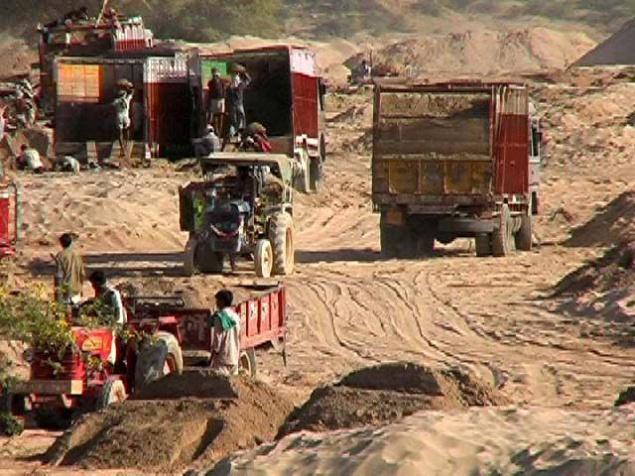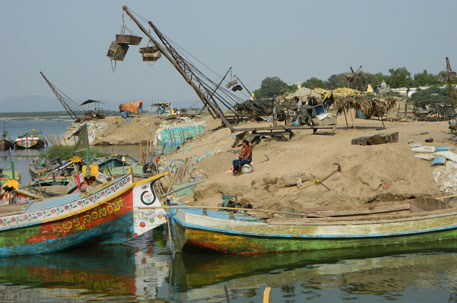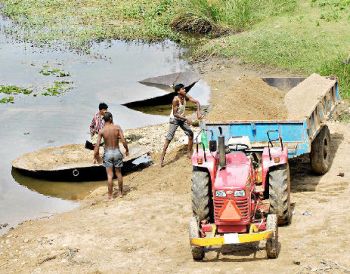
Pahanbarri was a small village of 3000 people in Madhya Pradesh's Hoshangabad district. The 200-year old village was known for its fertile soil, thanks to being located on the banks of the Tawa, a tributary of the Narmada river. On August 1 this year, the river changed its course, broke its bank and entered the village. A thick layer of sand, up to four feet in height, now covers the thriving paddy and vegetables sown in 500 acres of its agricultural land about three months back. 258 houses, including 100 in people's fields, are completely damaged besides the village's drinking water wells that are full of sand now. About 100 acres of land which were fields earlier, is a part of the river now.
Residents of Pahanbarri have submitted a memorandum to the district authorities to relocate them completely as there is no hope of a return to normalcy even if they are compensated for their losses - a meagre Rs 15,000 per hectare of land that was cultivated. In the memorandum, the villagers have claimed that sand mining in Maroda village, upstream of Pahanbarri along the Tawa, has caused this damage and that if the mining continues, they will have to face more instances of flooding like this one.
Extensive illegal mining along the river bank rendered it weak. Due to heavy rainfall, when excess rain water was released from a dam upstream, the weak bank gave away, spreading a layer of water and then sand over the entire village. "The region witnessed similar heavy rainfall twice last year but the river never changed course. In Maroda, area which can be mined for sand is not demarcated so illegal mining is widely prevalent," said Basant Chauhan, a journalist with the regional daily Nav Duniya, who first covered the instance of flood in Pahanbarri.

Minor mineral
Needed mostly for construction of buildings, sand is a minor mineral as per the Mines and Minerals (Regulation and Development) Act, 1957. Mining a minor mineral does not require permission from the Central government and getting clearance from the state government is also relatively easier. Miners and sand mafia take advantage of this fact and exploit the rule. Even though the volume of sand mined is huge and causes disastrous impact on the environment, it is still considered a minor mineral and thus comes under relaxed regulations. in fact, a Ministry of Environments and Forests (MoEF) report recommends getting rid of this classification so that same rules can be applied for all minerals.
Sand mining was recently in the news when Durga Shakti Nagpal, an IAS officer from Uttar Pradesh, was suspended by the state government for allegedly acting against illegal sand mining. The officer had 66 First Incident Reports (FIRs) registered in the past six months and got 104 people arrested for illegal mining on the banks of the Yamuna and the Hindon rivers in Gautam Buddha Nagar district of Uttar Pradesh. 274 dumpers carrying illegally mined sand were seized on her orders and a fine of more than Rs. 54 lakh was collected between February and july this year. All this was enough to irk a mafia that operates more or less with politicians' support.
Even as newspapers ran a campaign against corrupt politicians having their way with bureaucrats, the impact of sand mining on the environment and river ecology failed to catch peoples' attention. Mining of sand is a nuisance not just in Noida or Gautam Buddha Nagar but in many rivers across the country, including major rivers like the Ganga, Narmada and Periyar. Although this has been a problem ever since the construction boom began in the 1990s, sand mining only caught people's attention recently because an IAS officer was involved and partly also because of Noida's proximity to the national capital. The flooding of an entire village - the destruction of livelihood and homesteads - in faraway Hoshangabad missed all eyes.
The problem
Sand brought down by a river in its channel is deposited on its banks over a period of time. A boulder from the mountain, when it falls into the river, get churned along the way to form fine particles of sand by the time it reaches the plains. "The river is like a factory that converts boulders into sand. It takes thousands of years for a rock near Goumukh, the source of the Ganga, to become sand at the Sangam in Allahabad," says Anupam Mishra, environmentalist at the Gandhi Peace Foundation. This sand deposits on the sides of the river, forming a strong bank over the years that absorbs the force of the water and does not let it go out of its channel.
 For ages, people have used sand from the river banks for construction. They would dig out just enough for their requirement and let it replenish. But with the construction boom in the country, the builders do not think twice about extracting the freely available material. It takes minutes to remove a few trucks of sand with an excavator and weaken the bank. "The new soil that fills up the banks as a result is not so strong to absorb a gush of water, forcing a river to leave its channel," said Mishra.
For ages, people have used sand from the river banks for construction. They would dig out just enough for their requirement and let it replenish. But with the construction boom in the country, the builders do not think twice about extracting the freely available material. It takes minutes to remove a few trucks of sand with an excavator and weaken the bank. "The new soil that fills up the banks as a result is not so strong to absorb a gush of water, forcing a river to leave its channel," said Mishra.
This is what happened in Pahanbarri. "Due to rain, the Tawa river was in full steam. Tawa dam, 8 kms upstream of the village, released six lakh cusecs of water to prevent flooding in the upstream areas of the dam. Had the banks not been cut by miners, this sudden discharge would have just flowed down in its channel," said Kashmir Uppal, a farmer activist in Itarsi, the block in which Pahanbarri village falls under. "From ancient times, civilization has happened near rivers because of their ecological benefits. If the river turns its face, what will happen to the civilization?" said Uppal.
How is sand mining affecting aquatic life?
Besides strengthening the banks, sand serves as the habitat of many small species in the river. "Sand in the river harbours algae, mussels and other small creatures which the fish feed on which in turn become prey to larger fish. The collapsing of the river banks increases the sediment load of the river and the turbidity (haziness or cloudiness) downstream of the collapsed banks. This results in the disturbance of feeding systems of the fishes, which require the ability to see for feeding. "Extracting sand from the river is like cutting a forest and killing the prey animals. How can one save the tigers then?" said Uppal.
What is happening to the gharials in the river Ganga is a glaring example of what Uppal says. Sand mining in the National Chambal sanctuary, a rich habitat of gharials at one time, reduced their population by 60% in five years (1998-2003) and has almost rendered them extinct now, with only a small population remaining in the wild. The Gharials lay eggs in March/April and many of them are crushed underneath the miners' tractors. When the eggs hatch in monsoon, many juvenile gharials are swept away by floodwaters.
Sand mining and groundwater recharge
Sand also acts as an aquifer and helps to keep ground water recharged. "Sand acts like sponge. In our Ashram, one can find water at 20 feet but in nearby villages where sand mining is prevalent, water has gone down below 80 feet," said Swami Shivananda of Matri Sadan in Hardiwar, a religious trust campaigning against sand mining. In 2011, Swami Nigamananda of the same Ashram succumbed to his fast unto death while protesting against sand mining and crushing. Mining sand increases the capacity of a river to extract more soil from the banks downstream, leading to erosion, change in the flow of the river and increase in its depth. As the river system lowers, groundwater in nearby areas is affected. The water level in nearby wells thus goes down, affecting agriculture and drinking water needs of a civilization near the river.
Sand and the economy
Commercially, however, sand is the biggest raw material in modern construction practise. And in a GDP driven growth model, construction is the biggest industry in India today. "All our film stars promote housing complexes for a fee and even leading newspapers, which campaigned against corrupt politicians in the Nagpal case, have their own property supplements that promote high-rise residential buildings in Noida. We do not realise that the pace at which construction is happening in Noida, the day is not far when the river will change course here too and destroy the same high-rises that have used its sand for their construction," said Mishra.
The ratio of cement to sand in a concrete mix ranges from 1:6 to 1:12 depending on what is being constructed, which means 1 part cement has to be mixed with 6 to 12 parts of sand. Given that the installed capacity of the cement industry in India is more than 350 million tones per annum (source: Indian Brand Equity Foundation) not less than 2100 million tones of sand is consumed in India every year. Between 2006 and 2011, cement consumption in India was dominated by residential real-estate construction to the tune of 63% (source: Global Cement magazine) followed by infrastructure (20%). All this sand is derived from the banks of rivers (riverbed) as desert sand is not suitable for construction. "Desert sand particles are more rounded and salty. Mixing it with concrete is difficult as one needs rough edges to bind well with cement," said R.Sreedhar, chairperson of the NGO Mines, Minerals and People.
Even in this day and age, there is no machine that can convert big rocks into powder like sand or gravel. Despite such large scale commercial use, it is categorised as a minor mineral, a definition which only benefits the mafia that controls sand mining. There have been many cases in all parts of India where people who opposed sand mining have either been murdered or suffered attempts on their life. In Noida itself, an activist Mangeram who protested against illegal sand mining was shot dead on July 31. Three years ago, the mining mafia fired at the then SDM of the city Vishal Singh who managed to escape. In Mumbai, Sumaira Abdulali, founder of the Awaaz Foundation, an NGO campaigning against sand mining, was attacked twice while on a field visit. In cases like Pahanbarri, where media attention is minimum, there is no way of knowing the threats at all. "I think after Bellary, maximum mining in the country takes place in the Narmada river. Trucks and JCBs can be seen parked right in the middle of the river," said Uppal.
What does the law say?
According to the Mines and Minerals Act, the state government has the authority to give clearance for the mining of minor minerals. But the Environment Impact Assessment notification issued by the MoEF in 2006 stated that no clearance was required for mining in a plot less than 5 hectares. "Taking advantage of this clause, miners started applying for multiple mining leases of less than 5 ha in the same region, with one person owning more than 5-10 leases with only a few metres of distance between them," said lawyer Rahul Chaudhary, who filed a case against sand mining in UP in the National Green Tribunal (NGT) on behalf of its bar association.
Meanwhile, in September 2010, the Mumbai High Court issued a blanket ban on sand dredging in Maharashtra as there was no comprehensive policy around it. Though the state government did come out with a policy that empowered local communities to have a say in sand mining in their areas, the ban hit the the construction industry badly and threatened high profile government projects too. As per newspaper reports, the shortage led to unfair business practices and the cost of sand almost tripled - from Rs 6000 to Rs 16000 per truckload - besides affecting employment in the building industry. The ban cost the state exchequer Rs. 800 crore before it was lifted in October the same year.
In 2011, a little before Swami Nigamanand's death, the Uttarakhand government enforced a ban on sand mining in Haridwar, calling it a sacred region. "Miners in connivance with corrupt politicians are now trying to revoke the ban by putting up arguments like excess silt and boulders from upstream will lead to flooding in the Ganga and they need to be removed to prevent the disaster. If boulders were actually coming down in the river, they would have filled Tehri dam years ago," said Swami Shivananda.

The 5 hectare rule changed with a February 2012 Supreme Court order, popularly known as the Deepak Kumar judgement. "The judgement made environmental clearance from MoEF compulsary for all sand mining projects, even those below 5 hectares," said Chaudhary. The Supreme Court (SC) also ordered that the state governments should strictly comply with the MoEF recommendations of 2010 which said that a cluster approach should be adopted for mines operating in less than 5 hectares. The report said that mining of minor minerals needs to be regulated just like that of major minerals and called for a re-look at the definition of "minor" minerals. Besides this, the report recommended a mine plan, like the one prepared in case of major minerals, for reclamation and rehabilitation of mined areas.
The uproar following the Durga Shakti Nagpal suspension revealed how the SC order is being flouted completely all over the country.The NGT bar association thus filed a case against the UP government for allowing illegal sand mining near the Ganga, the Yamuna and some other rivers in the state that was costing the state exchequer crores of rupees. The NGT on August 5 issued notices to the UP police and others involved and reiterated the SC order that no mining should be carried out without prior environmental clearance. Just two days later, when an MoEF team visited Greater Noida to find out the extent of illegal sand mining, it was found that mining continued discretely. The site visit report mentions that the miners had just flooded the depressions created by extraction of sand by diverting water from the Yamuna.
When asked if the order was being followed in Hoshangabad where Pahanbarri falls, Rajiv Jain, the collector, said that the lease for most mines has anyway expired in the district but did not confirm if actually no illegal mining is taking place. Had Pahanbarri been in Delhi, like the flooding disaster in the village, this question would not have eclipsed the public eye.
Alternatives to sand
All this shows that no bans can stop a business so strong as infrastructure unless there are alternatives in place. Some experts suggest mining rejects, copper slag, blast furnace slag, quarry dust, bottom ash and construction and demolition waste as better and stronger replacements for sand in concrete mixes. But most of these things are outputs of some or the other industrial process, which itself may be polluting.
"Why can't we just reduce the need of sand? Why do we need to follow the building norms that are totally dependent on concrete? For instance, one does not need solid walls inside the house. If all the walls between our drawing room and the last bedroom are made of bamboo or board, the requirement of cement and thus sand will come down manifold," said Sreedhar.